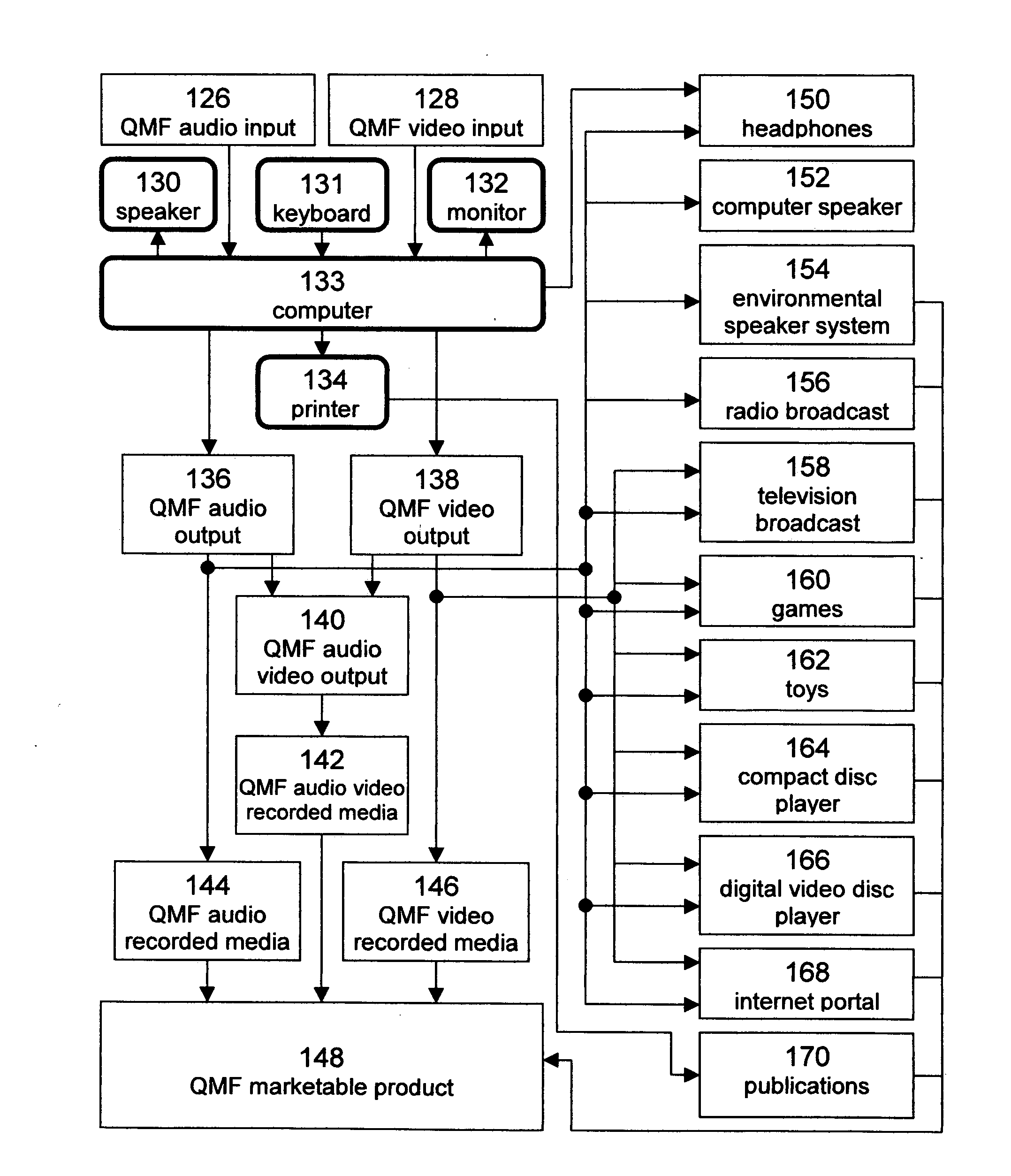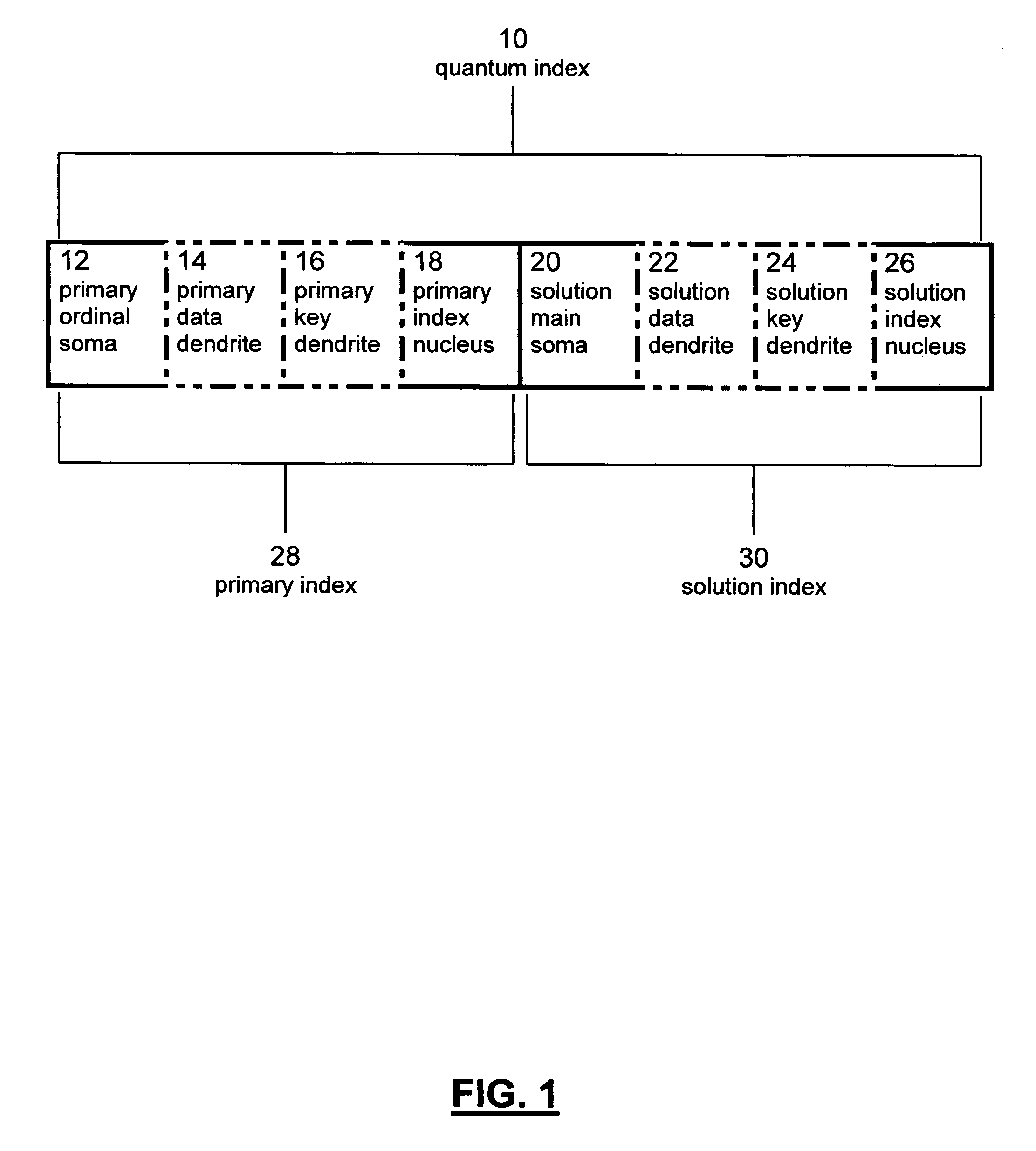More specifically, methods hereto devised and utilized for the aforementioned purposes are known to consist of basically familiar, expected and obvious configurations and methods, and limited results, notwithstanding the myriad of methods and configurations encompassed by the crowded prior art which have been developed for the fulfillment of countless objectives and requirements, the collective theories and presuppositions of which are incorporated herein and by reference.
The first main problem is that conventional
scientific theory attempts to explain mnemonics as a mysterious abstract of the human process.
Consequently, methods, devices, and apparatus depicted by the prior art are therefore incorrectly mnemonically applied.
The second main problem is that it is unspecified and unknown in the prior art the role that mnemonics serve in abstract ocular and auricular applications transmitted at the sub-threshold.
Failure to understand and abide by this covenant forces neuronal memory blocks to relegate the abstract content of the prior art to mere fantasy or phantom construct.
Because popular
scientific theory and otherwise believed concepts, previous ideas, products, devices, books, papers, apparatus and all of the prior art ignored this significant relationship, abstract audio content is therefore erroneously produced and administered to users of the prior art.
Another problem is that the prior art references and cites, but can not answer why the experiment performed by Becker U.S. Pat. No. 3,278,676 (1966) was not completely successful or why it produced any result at all.
The prior art can not produce tangible results in sixty-minutes (one hour) or less.
The prior art can not create an intra-cranial
harmonic “voice” that literally speaks from within the molecular structure of neurons in the brains of users, and that reinforces the data and assists users in problem solving.
The results yielded, if any, from the prior art are speculative.
Second and subsequent users of the prior art, to include a global
population of users, can not duplicate the results that a first user may obtain from the prior art.
Even the limited results yielded by the prior art are not permanent.
After more than twenty-five years of consistent, serious investigation and experimentation, scientists and notable celebrities practicing in the sub-threshold, mnemonic, and
behavior modification industries are incapable of reaching every living person with inexpensive products that produce tangible, measurable, immediate, and permanent results.
Users of the prior art can not remember or recite from, nor directly or immediately benefit from treatments offered by the prior art.
The prior art can not
exploit the unfiltered storage capabilities of the right cerebral hemisphere.
The prior art fails to capitalize on the raw
processing power of the right cerebral hemisphere.
The prior art fails to capitalize on the high-speed data absorption capabilities of the right cerebral hemisphere.
The prior art fails to benefit from the virtually unlimited storage capabilities of the right cerebral hemisphere.
The prior art fails to capitalize on the creative problem solving ability of the right cerebral hemisphere.
The prior art requires long-term use to effect even modest
behavior modification, but the general
consensus is that said modifications are so slight as to be intangible or that the results conceivably represent the byproduct of an extraneous, unexplained external stimulus such as time or contact with other individuals or groups.
Apparatuses promoted within the prior art are typically hard to find, difficult to construct, immobile, bulky, expensive, require training before potential benefit, require ancillary programs to function, or need assistance and supervision from trained persons for role play or role modeling.
The prior art induces discomfort from wearing goggles or lenses; electrodes attached to a user's body, wearing external
sensory input or output devices, or encapsulation in a closed room or other containment structure.
The prior art can not fuse data directly to any portion of a brain.
The prior art can not retrieve data fused to a brain.
The prior art can not erase data previously fused to a brain.
The prior art can not update or modify data previously fused to a brain.
The prior art can not create specific
directory structures on the brain and later fuse data into said directories.
The prior art contains no formula that is easy to understand by those unskilled in the art.
The prior art can not be utilized with every form of known media, to include, written text, the spoken word, still imagery, motion pictures, and music.
Another problem is that the widely accepted definition of “sub” when combined with “limen” is inaccurate and misleading because of the prior art.
Other problems within the prior art will become apparent in later sections.
The plurality of role models required create an obvious expense.
The difficulty of determining whom the trainee perceives as a role model practically renders this device unusable in commercial settings.
This method fails because at least one element of the modification may be inaccessible during daily activities.
There is no empirical evidence to support the connotation that what one sees in the mirror (as a reflection) is a catalyst for behavior modification.
The Frenkel process is counterproductive because it interrupts the cognitive
motor function signals from the right cerebral hemisphere, which is responsible for primary
emotionality, which manipulates facial
muscle contractions based on neuronal signaling of a spatial expression, creating physiological vacillation that falsely attests to ones state of being.
Thus, the therapeutic value of the Frenkel device in
psychiatry is seriously questionable as the device is in direct opposition of healthy neurological responsiveness.
Based on Densky's patent, the two images conflict in actual and symbolic representation because the perceived undesired
habit has substantial mnemonic reinforcement.
Thus, this method also fails to achieve permanent behavior modification.
This method is obvious and the results speculative.
Further, the cost of the D'Alitalia and Mead product versus an insignificant
probability of success disqualifies this prior art as a viable means for behavior modification.
The
list of alternate responses may be unsuitable to the user, creating a hesitancy for compliance.
Will-power is an illusory means of behavior modification.
First, it is impossible to increase the capacity of the
human brain because humans can not synthetically manufacture neurons.
Second, it is impossible to improve the
information processing capacity of the
human brain because the brain processes all information at the same rate, as my invention will later prove.
Chai's method is useful for experimental purposes, but at the same time exorbitantly wasteful for any commercial application.
Depending on the size of the shopping area, the cost of the sensors and the probability of tactile output within the shopping area could be a serious deterrent to using the prior art.
The device is bulky, protrudes, and attaches to an expensive appliance.
The more the viewer attempts to focus on the screen, the harder it becomes to ignore the large panels protruding from the sides of the housing, thereby changing the abstract nature of the prior art to distracting tactilely visual messages.
Moreover, negative inferences have weakened for certain colors because of the logos of large corporations.
Mould's device becomes noisy, distracting, environmentally unfriendly, energy hungry, and cumbersome.
The need for users to purchase decoders, the inability of users to customize the messages, the expense of
purchasing multiple decoders from a plurality of manufactures of abstract media, and the requirement that users must continue
purchasing media from the same manufacture to avoid owning numerous unique decoders make the prior art undesirable for
mass commercialization, simple self improvement, behavior modification, and learning.
Numerous drawbacks exist in Taylor's methods.
First, if a user is deaf in one or both ears, Taylor's methods fail.
Second, the user invests substantially in single purpose equipment, the elaborate arrays of audiocassette decks are expensive and not readily available, the
user needs an advanced knowledge of electronic circuitry, and the user must solicit two other people to
record a simple self-help message.
Taylor's methods are impractical for the average person.
Third, a child can not
record messages relating to
sexual dysfunction, intimacy, and other mature, but every day subjects, thereby severely limiting product use in the adult audience.
Thus, an abstract message delivered to the right auricular orifice exclusively can not produce a permanent recallable memory in the left hemisphere of the brain.
Therefore, the messages will never produce a conscious response and serve no purpose for the user.
Again, Taylor's methods fail.
Fifth and yet another problem is that Taylor's “round-robin” claim contradicts known neuropsychological functions.
Sixth, another problem in Taylor's method centers on his use of multiple authors on the same abstract channel, producing a variety of forward and backward, spoken and sung recordings.
The refracted
wavelength of the sound produces audibly torturous delays in the sound transmission and makes such a conversation, annoying, confusing, unintelligible, and useless.
Taylor's approach is excessive, unnecessary, and refutable according to Becker who used two simple statements recorded in the normal forward method, both of which, to some extent, influenced the left brain hemisphere to recall memories from the right brain hemisphere of some store employees and some customers.
Taylor diminishes any plausible benefit of the messages because Taylor presents the messages as a
cryptogram to the
right hemisphere of the brain, which results in the creation of incomplete neuronal memory blocks, thus severely delaying interpretation and recall of the messages.
Consequently, the “whole brain” approach and the “round-robin” method depicted in the prior art promote mnemonic indifference, excessive neuronal
noise, possible
anxiety, and questionable utility value to users.
While these methods and devices attempt to fulfill their respective, particular objectives and requirements, the aforementioned patents do not describe a method for
quantum memory fusion.
Furthermore, the prior art does not teach any known methods for
quantum memory fusion.
Unfortunately, the treatise, books, and articles written since 1710 are saturated with intriguing intellectual theory and presuppositions and therefore led humankind on a three-century pursuit for answers.
Until the 1950's, previous theories could not even benefit from advances in technology.
These products met with great scrutiny, as consumers demonstrated considerable discernment about the use of such products in their daily lives.
Product manufacturers could not substantiate claims because no result could proven to be the result of the abstract media.
Major retailers refused to stock or sell such products.
computer. Although there are numerous similarities, this theory is m
are either stored in the
synaptic cleft or not stored at all, just “fou
remembered 408 to 544 items in one hour. There were no visual clues or interactions with the data after the experiment concluded. Interestingly, the data that did not fuse created
no
data records. This is why traditional methods of learning are slow. <b class
previously fused data can be erased from memory although other neurons have attached to the
memory block and created extraneous synapti
First, it is possible that not all patrons
spoke English.
Because of my findings, the current definition of the word “sub” combined with the word “limen” is improbable.
However, the events are unendorsed by other neuronal memory blocks and too disorganized to recall.
Inasmuch, the understanding of mnemonic workings is limited.
What is thought to be understood by other scientists is lacking in supporting evidence.
That alone will make the memory useless for purposes of recall.
However, that alone will not make the memory recallable, only permanent.
Delivering secure documents
pose risks to the carrier and the data.
Quantum Memory Fusion is easily duplicable by a person skilled in the art and is suitable for
mass manufacture and distribution by a plurality of manufacturers and distributors, and offers an extremely low production and raw materials cost, and has an unsurpassed availability rate for materials and equipment.
 Login to View More
Login to View More  Login to View More
Login to View More 


